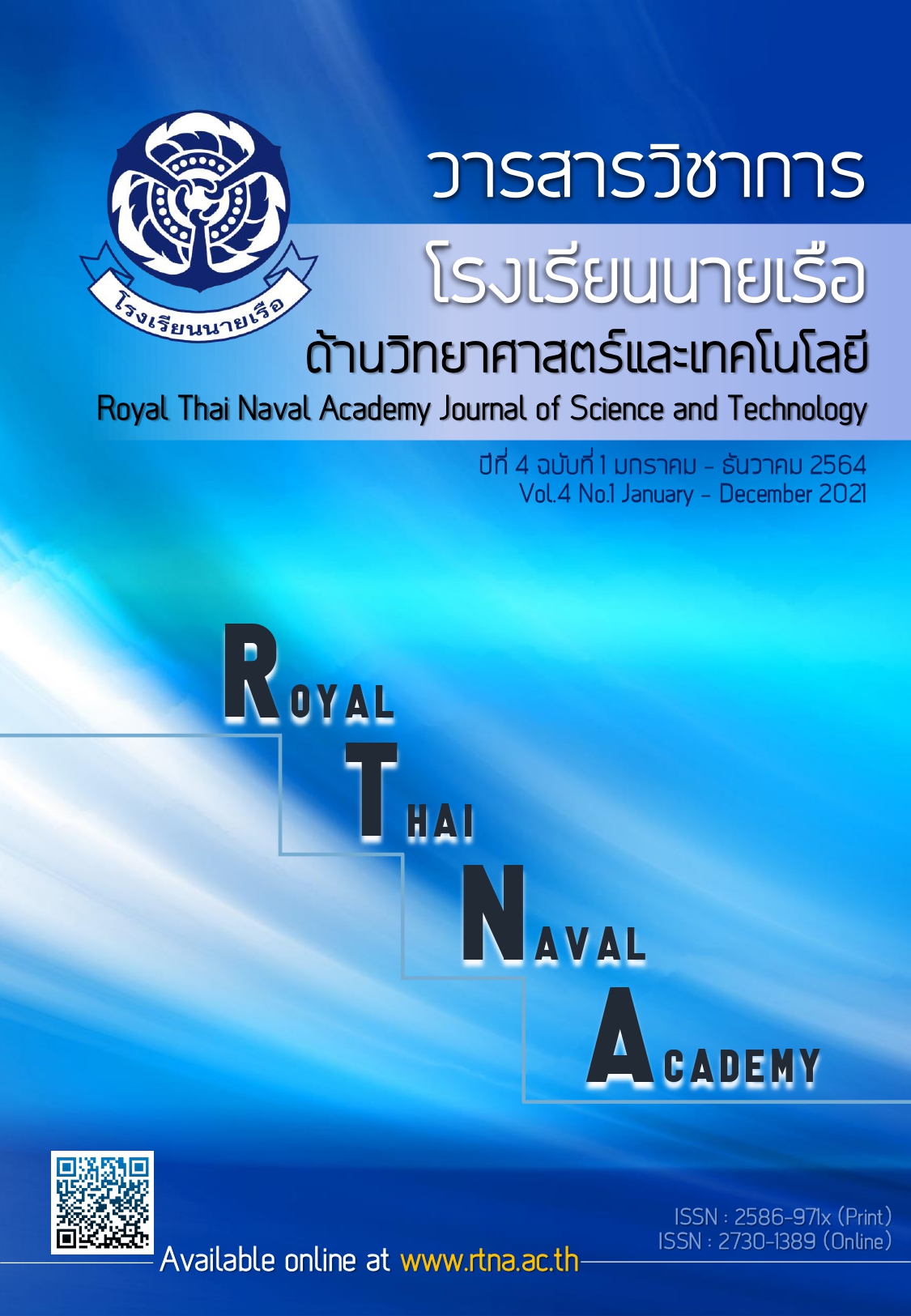แนวทางการควบคุมอัคคีภัยและความเสียหายขั้นสูงในเรือรบ
Main Article Content
บทคัดย่อ
เรือรบเป็นอาวุธยุทโธปกรณ์ที่มีความเป็นเอกลักษณ์พิเศษเฉพาะตัว ทุกส่วนของเรือรบถูกออกแบบให้ปฏิบัติการทางทหารเพื่อรักษาความมั่นคงและรักษาผลประโยชน์ของชาติทางทะเลสูงสุด ดังนั้นกระบวนการสร้างและออกแบบจึงตัวเรือจึงเกี่ยวข้องกับเทคโนโลยีทางวิศวกรรมหลายสาขา เรือรบถูกออกแบบให้มีความซับซ้อนเชิงโครงสร้างออกแบบเป็นบล็อกหลายๆบล็อกมาประกอบกัน โดยมีห้องต่างๆในเรือจำนวนมากตามภารกิจทางทหารและหลักการทรงตัวของเรือในทะเล จำนวนห้องต่างๆมีผลอต่อระบบการป้องกันความเสียหายทางเรือ (Damage control) ซึ่งแต่ละห้องนั้นถูกออกแบบเป็นพิเศษ เช่นห้องเครื่องจักรใหญ่ ห้องไฟฟ้า ห้องเก็บคลังกระสุน ห้องควบคุมการยิงห้องครัว และห้องพักทหาร ความแตกต่างของห้องทำต้องให้เลือกดับเพลิงที่แตกต่าง
เทคโนโลยีด้านการป้องกันและดับเพลิง ประกอบด้วยอุปกรณ์สัญญาณแจ้งเตือนอัคคีภัยต่างๆ อาทิอุปกรณ์ตรวจจับควันไฟ (Smoke Detector) อุปกรณ์ตรวจจับความร้อน (Heat Detector) และอุปกรณ์ดับเพลิงขนาดใหญ่ เช่นอุปกรณ์หัวกระจายน้ำดับเพลิงอัตโนมัติ (Water Mist High Pressure) อุปกรณ์ดับเพลิงชนิดก๊าซ (Gas Suppression System) และระบบโฟมอัดน้ำแรงดันสูง (Foam Suppression System) เทคโนโลยีต่างๆเหล่านี้จะช่วยเพิ่มขีดความสามารถของเรือด้านการป้องกันความเสียหาย แต่ยังอยู่เพียงในขั้นตอนทดลองและพัฒนาไปสู่เรือต้นแบบในอนาคตเท่านั้น ปัจจุบันเรือเดินสมุทรได้เริ่มนำเทคโนโลยีป้องกันความเสียหายมาใช้งานบ้างแล้ว โดยรวมทุกอุปกรณ์ตรวจจับเพลิงเข้าด้วยกันที่เรียกว่า อุปกรณ์ตรวจจับแบบองค์รวม แต่สำหรับกรณีเรือรบแล้วปัญหาจำนวนห้องกับอาวุธยุทโธปกรณ์จำนวนมาก และเกณฑ์กำหนดต่างๆของกองทัพเรือล้วนแล้วแต่เป็นปัจจัยสิ่งท้าทายที่รอการทดสอบ
นอกจากการพัฒนาอุปกรณ์ตรวจจับแล้ว แนวทางการลดเชื้อเพลิงของวัสดุที่ไม่ใช่โลหะ (Polymeric) ก็มีบทบาทสำคัญอย่างยิ่งต่ออัตราการเกิดไฟไหม้ หากเลือกใช้วัสดุพอลิเมอร์ (Polymer) ที่มีคุณสมบัติทนไฟ และสารเคลือบผิวโลหะทนไฟระดับนาโน (Coating) บนอาวุธยุทโธปกรณ์ในเรือแล้วจะเป็นอีกทางเลือกสำคัญหนึ่งในการป้องกันความเสียหายทางเรือ
Article Details
เนื้อหาและข้อมูลในบทความที่ลงตีพิมพ์ในวารสารวิชาการโรงเรียนนายเรือ ด้านวิทยาศาสตร์และเทคโนโลยี ถือเป็นข้อคิดเห็นและความรับผิดชอบของผู้เขียนบทความโดยตรง ซึ่งกองบรรณาธิการวารสาร ไม่จำเป็นต้องเห็นด้วย หรือร่วมรับผิดชอบใด ๆ
บทความ ข้อมูล เนื้อหา รูปภาพ ฯลฯ ที่ได้รับการตีพิมพ์ในวารสารวิชาการโรงเรียนนายเรือ ด้านวิทยาศาสตร์และเทคโนโลยี ถือเป็นลิขสิทธิ์ของโรงเรียนนายเรือ หากบุคคลหรือหน่วยงานใดต้องการนำทั้งหมดหรือส่วนหนึ่งส่วนใดไปเผยแพร่ต่อหรือเพื่อกระทำการใด ๆ จะต้องได้รับอนุญาตเป็นลายลักษณ์อักษรจากโรงเรียนนายเรือก่อนเท่านั้น
เอกสารอ้างอิง
กองทัพเรือ. ยุทธศาสตร์กองทัพเรือ 2558 – 2567 [อินเทอร์เน็ต]. กรุงเทพฯ: กองทัพเรือ; 2558. [สืบค้นเมื่อวันที่ 28 ม.ค. 2564]. จาก: http://www.navy.mi.th › upload › pdf › strategic
ไกรสุเนตร เห็มสุข. การพัฒนาการต่อเรือรบไทยภายใต้ความร่วมมือระหว่างกรมอู่ทหารเรือกับ ภาคเอกชน. วารสารกรมอู่ทหารเรือ. 2563:76-84.
ความรู้พื้นฐานงานดับเพลิง. นิตยสารเซฟตี้ไลฟ์. ธ.ค. 2563-ม.ค. 2564;(152).
ศูนย์ศึกษายุทธศาสตร์ทหารเรือ. ความรู้เบื้องต้นงาน ปคส [อินเทอร์เน็ต]. กรุงเทพฯ: ศูนย์ศึกษา ยุทธศาสตร์ทหารเรือ; 2550. [สืบค้นเมื่อวันที่ 28 ม.ค. 2564]. จาก: http://110.49.60.146/thinktank/?p=2597
ศูนย์ศึกษายุทธศาสตร์ทหารเรือ. หลักนิยมทางทะเลของกองทัพเรือ [อินเทอร์เน็ต]. กรุงเทพฯ: ศูนย์ ศึกษายุทธศาสตร์ทหารเรือ; 2550. [สืบค้นเมื่อวันที่ 28 ม.ค. 2564]. จาก: http://110.49.60.146/ thinktank/?p=2597
John FG Wade. Navy tactics doctrine and training requirements for littoral warfare [dissertation]. California: Naval Postgraduate School; 1996.


